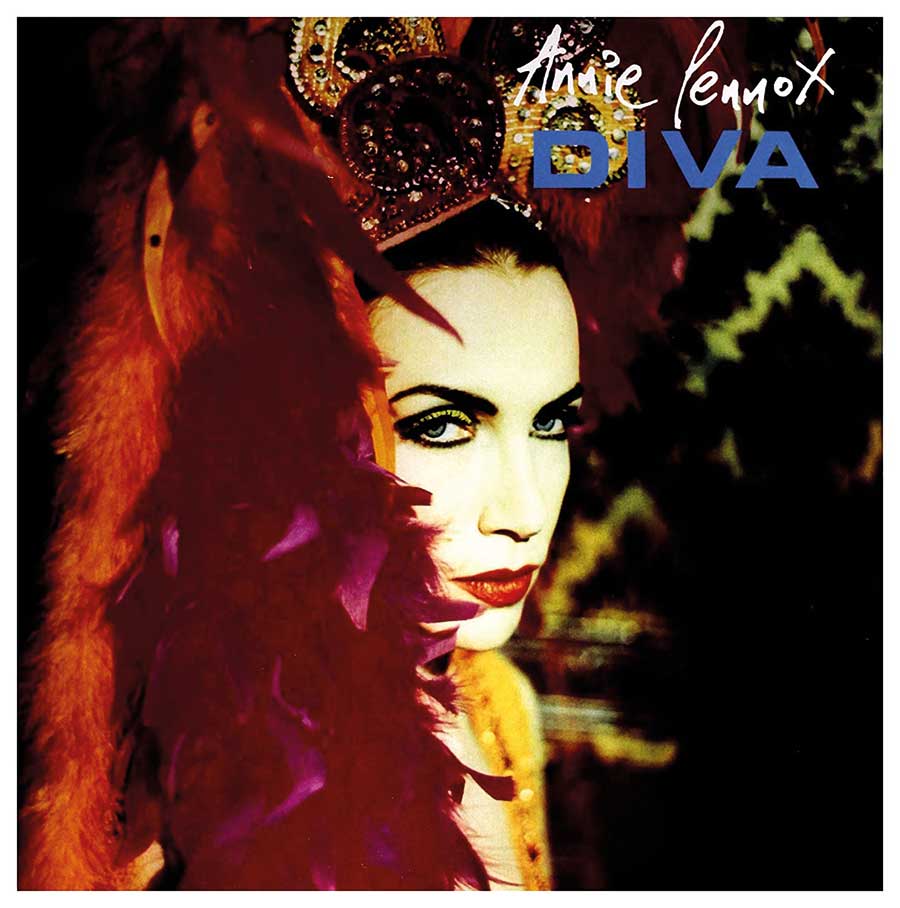
Annie Lennox Diva cover
Classic Pop takes a deep dive into Annie Lennox’s multi-award-winning solo debut, Diva, the 90s album that reaffirmed her status as a soul-pop diva, proving she needed nobody to prop her up… By Felix Rowe
Anyone who’s ever been branded a ‘bit of a diva’ will attest it’s not exactly a compliment, let alone a label that you’d choose to describe yourself. Larger than life, bit of a show-off, maybe harbouring ideas above your station.
Yet if anyone has ever had the right to claim that epithet – in its truest sense – it was Annie Lennox at the turn of the 90s.
Indisputably the UK’s most successful female artist at that point, Annie had topped the charts the world over as one half of Eurythmics – with four BRITs, a Grammy and three Ivor Novellos already to her name.
The perfect marriage of style and substance, her peerless, pioneering image was matched by soulful powerhouse vocals.
While some of her 80s A-list contemporaries were rather unceremoniously cast aside at the turn of the decade, Annie’s 1992 solo debut Diva shored up her position.
The self-assured collection – positively stuffed with hits, from the irresistible Walking On Broken Glass to the gospel- tinged Why – cemented Annie’s status as a timeless star for any era. A truly formidable diva (and yes, that is a compliment).
But what you see isn’t always what you get, especially with Annie Lennox. As she explained in a BBC2 special to accompany the album’s release, the diva image was loaded with irony.
“It’s quite an arrogant thing to take that name and put it on yourself. It’s like taking a crown and putting it on your head, in a way. But I do it with a smile because the diva that you see, the person in performance, is not necessarily the person that I am.”
Understanding this notion is central to unwrapping the themes of the record, and the picture is fully realised through the accompanying visuals, directed by long-term Eurythmics collaborator and music video auteur, Sophie Muller.
Muller remains one of the most in-demand directors in the industry (Blur’s Song 2, The Killers’ Mr Brightside, No Doubt’s Don’t Speak are just a few), but Lennox has proved a particularly inspiring and enduring muse.
Diva was pioneering with the simultaneous release of a video album containing seven music promos (with an additional two more added later in the repackaged Totally Diva version) – long before Beyoncé famously made the ‘visual album’ a thing.
The promos explore that juncture between an icon – an exhibit to be idolised, analysed or gawped at – and the real human beneath that veneer. A running theme is that state of transformation from one to the other.
Diva-esque
“As a performer,” Annie explained to the BBC, “I’ve lived that diva-esque existence. Being in a little box, and having that box opened up, night after night, when you come out and perform and everybody sees this thing, this entity, and then go back and disappear, and pack your suitcase…
“I’ve experienced that balance of being the public person that is this monstrous kind of diva, a personage, and then trying to maintain my life.”
When in costume, Lennox is a formidable presence. The larger-than-life diva make-up and the bright, feathered headdress (borrowed from the Bond film, Octopussy) is essentially her suit of armour, a femme-fatale forcefield.
Then, just beneath that shiny, sequined veneer – the real human, baring her soul. Or, in the words of Rolling Stone, “an ice queen thirsting to be melted by love.”
“Sometimes, I’ve actually had people say in front of me: ‘She’s famous, isn’t she?’ Right there, in front me, like I didn’t exist… and I’m just standing there, you know? It’s very, very odd. It’s all to do with walls and veils, you know?” mused Lennox in the BBC documentary.
Come the launch of her solo career, Annie now had a new facet of her diva character to tap into: that of motherhood, the ultimate expression of femininity. Following the tragic loss of a stillborn son in 1988 – which she has since acknowledged had a profound effect on her – she gave birth to her first daughter in 1990.
Annie explores the theme in Money Can’t Buy It, in which she exclaims, “I believe in the power of creation”. A mother’s unconditional love for a child transcends any trappings of success, fame and money.
Lyrically, the album drips with heartbreak. Even the insanely catchy, serotonin-boosting monster of a pop song Walking On Broken Glass is lyrically a gut-wrenching tale of heartache. Diva is laced with self-reflection, but never wallows in self-pity; there’s a defiance and also an optimism present.
Annie professes a connection with the pibroch – a traditional style of music played in Scotland on the bagpipes; what she describes as a piper’s lament following a battle, which, she says, reflects in her penchant for slow, mournful ballads. This is evident on Diva. While packed with her now signature earworms, the record is often subdued and sombre.
Why not?
Why has rightly become Annie’s totem, though at first it was a brave choice of lead track to launch her solo career. Everyone knows the album promo drill: kick off with the banger, then follow up with a heart-wrencher only when you’ve got everyone’s attention.
Annie chose to do the opposite, announcing Diva’s arrival with a slow, subtle and intimate ballad leaving herself extremely exposed – but taking full command in the process.
Of her time in 1970s new wave outfit The Tourists, Lennox has said that it was a learning ground for making mistakes, getting wise to the ‘industry sharks’, discovering who she was as an artist.
In Eurythmics, she flourished in a strained but fruitful partnership with former beau, Dave Stewart. They achieved success on their own terms, but now the time had come to take total control.
By the end of the last Eurythmics album run, Lennox felt she’d said “all she had to say”. Annie needed to call a halt, step out of the whirlwind, take a breath and start anew. Diva would be the album to prove Dave Stewart wasn’t the only brains behind the operation.
Some may have wondered whether Annie could go it alone. Talking to the BBC, Lennox admitted to asking this very question herself, suggesting it was once unthinkable that she could write a record without Dave. She needn’t have worried.
Annie is the sole writer of eight out of the 10 original tracks here and co-writes the remaining two. She’s acknowledged that her ability to write songs is what helps to affirm who she is.
In 2015, Annie became the first woman to be made a fellow of the British Academy of Songwriters, Composers and Authors (Ivors Academy) – more recently joined by Kate Bush in 2020.
But while Lennox was in total artistic control, a crack team of production talent and session musicians was assembled around her in top London studios to help the singer realise that vision on tape.
The result, under the guidance of producer Stephen Lipson (Trevor Horn’s assistant and co-writer of Slave To The Rhythm), is reassuringly expensive sounding. The vocals may be raw and fragile; the production most certainly is not.
Pop shimmer
Viewed from 30 years’ distance, Lipson’s production now feels slightly dated – a glistening pop shimmer coating the funky, soulful arrangements.
Compared to another singular female talent, Björk’s Debut, which dropped the following summer, it’s not edgy, groundbreaking production. Rather it serves the songs with a pop flourish, very much in the mould of contemporary dinner party soul of the era, as served up by Simply Red, M People and latter-day Genesis.
Ironically, the freshest and most timeless sounding track is the retro-1930s pastiche, Keep Young And Beautiful, which pre-empts the jazzy pin-up revivalism later popularised by Amy Winehouse and Caro Emerald.
But what makes Diva stand apart is the strength of its songwriting, conviction of delivery and singular conceptual thread running throughout.
With largely the same team on board, Annie repeated the success on her 1995 covers album Medusa, which again hit No.1 in the UK, spurred by the single No More I Love You’s.
In the years that followed, Lennox has, of course, built on the foundation laid down by Diva, with yet more awards, including an Oscar, and now has a total of six studio albums to her name. From this new-found position of personal strength, she even made Peace with Dave Stewart in 1999.
But Diva remains her ultimate calling card. The album’s significance in Lennox’s canon was highlighted by her memorable Live 8 performance at Hyde Park in 2005. All the big-hitters were there – the old legends and the popular contemporary talent.
At this particular stage of her career, Annie was firmly planted in the ‘legends’ category, long past the point of representing pop’s current cutting edge.
Two of the three songs in her set were taken from Diva, including a rocking rendition of Little Bird. But it was her touching, stripped-back performance of Why, with lyrics repurposed to fit the fight against poverty, that absolutely stole the show.
No feather boa, no headdress, no razzmatazz; with just a phenomenal vocal and simple self-accompaniment on keyboards, she totally outgunned them all. Not even a reunited Pink Floyd could come close. That, boys, is how it’s done.
Annie Lennox: Diva – the songs
Why
Opening with that immediately recognisable soulful vocal refrain, it’s a curiously understated start to the album, finding Annie soul-searching. “Why is a deep dialogue with myself in a funny way,” Annie told the BBC. “A song about communication, or lack of communication.”
As it builds into a rapturous crescendo, the mood shifts from questioning and personal doubts to a fierce and emotional call to arms, what Lennox calls, “a denouncement of things that have been applied to me that I feel are not me.” She is righting the wrongs, challenging the preconceptions of her character, by affirming what she isn’t rather than declaring what she is: only she knows the real Annie.
Stereogum aptly referred to Why as the five stages of grief set to music. The single reached No.5 in the UK charts, kept at bay by Shakespears Sister’s Stay (whose haunting video, incidentally, was directed by regular Lennox collaborator Sophie Muller).
Walking On Broken Glass
From that jaunty piano riff and baroque programmed strings onwards, Walking On Broken Glass is an instant hit. Deliciously catchy and immediately familiar, it’s the type of track that every self-respecting pop star would give anything to have in their arsenal.
There’s a wicked juxtaposition between the heartache of the lyrics (sample phrase: “every one of us was made to suffer”) and nagging groove. Her broken heart may well be battered and bruised, but it’s throbbing to a funky beat.
The greatest question, though, is why it only reached No.8 on the UK singles chart? And what megaliths were standing in the way of this juggernaut? (Culture Beat’s Mr Vain as it happens).
Precious
By far the hardest-hitting track on the album in terms of the attack of its instrumentation, Precious is built around a low-slung bass groove that characterises a lot of early 90s sophisti-pop.
Shimmering production, lush vocals and a funky underpinning bristle against the slightly menacing, incessant minor key groove. A breezy, jazzy trumpet solo – oh-so-very 90s – recalls M People, early-era Groove Armada, and – dare we say it – The Lighthouse Family.
Legend In My Living Room
The simple programmed groove almost harks back to the Eurythmics of the early 80s, as Lennox muses over what her life might have been had success eluded her.
However, the vibe more closely resembles another pioneering synth-pop guy/girl duo – in a parallel universe, Legend In My Living Room might well have been what Yazoo would’ve sounded like at this point if they’d kept going; Annie’s big gospel-tinged vocals set to a sparse electro feels like an update of Situation, again building to a rousing crescendo.
Cold
While the quality levels never dip on Diva, the pace does and a change of tack sees the momentum slacken. Cold is one of the more sedate tracks on offer: a 90s slow-jam ballad, complete with obligatory rimshot snares and smooth synth washes.
It’s another emotive tale of heartbreak, as Annie confesses that “dying is easy, it’s living that scares me”. The fourth and least commercially impactful of the album’s five singles, Lennox has nevertheless spoken fondly of Cold, a staple in her stellar oeuvre of mournful ballads. Certainly, it suits her vocals absolutely perfectly.
Money Can’t Buy It
One of the most compelling tracks on Diva, the album’s centrepiece is a total showstopper, injecting some welcome pace back into proceedings. Initially chilled and laid-back, it’s announced with the inimitable sounds of a classic drum machine, while the song gradually builds to its rousing climax.
Annie goes full-on gospel, as huge live drums and electric guitar explode into the fray, until Lennox is practically rapping. The song is a powerful exaltation of the things that really matter and that no money can buy: the gifts of life and love.
Little Bird
Initially, this takes Annie into 90s house territory with that four-to-the-floor kickdrum and spacey synth groove, which morphs into a disco strut with dirty synths on the bassline. Curiously, the vibe sounds a little akin to a sped-up I Want To Break Free, mixed with a little Dangerous-era Michael Jackson, which proves a winning combination.
It’s the most up-tempo track on the album, and perhaps the closest Lennox gets to the Eurythmics’ more dance-oriented numbers. A live favourite, Annie has performed this at several milestone international events, including the London 2012 Olympics Closing Ceremony and Live 8.
Primitive
The pace drops again for a dreamy ballad with a spacey new age/world music feel. Synth pads are accompanied by simple percussion from tabla, later enhanced with sweeping Eastern-influenced strings. The haunting vocal runs, set deep into the background of the mix, are a neat touch – Annie’s voice cascades through Eastern scales, an interesting counterpoint to the central and more conventional vocal melody.
Stay By Me
After a cabaret-style piano intro, this chilled but uplifting groover rolls along on a ‘trip-pop’ vibe later popularised by Dido and Morcheeba. Post-club chillout record or ultimate 90s dinner party music?
It ably serves either function. Despite its six-and-a-half minutes and mid-tempo baggy plod, Stay By Me is a soothing tonic that washes over you, without outstaying its welcome.
A woody recorder motif again pushes the record into world music territory, while a lush, layered vocal harmony breakdown invokes Enya. The fact that this wasn’t released as a single shows the strength of songs on offer.
The Gift
The official final song on the vinyl tracklisting, The Gift is a subdued coda that drifts along on synth washes and vocal ‘doos’. Annie sings “take this gilded cage of pain and set me free”, set to twinkling pianos and a muted, distant-sounding percussive groove that’s barely there.
Keep Young And Beautiful
A bonus addition on the compact disc version (though not included on the original vinyl release), the only cover on the record is a golden oldie, supposedly a favourite of Winston Churchill. It’s produced in a jazzy, 1930s style with delicate piano, scratchy vocals, and ambient crackling and popping as if laid down straight to wax.
In Annie’s hands, Keep Young And Beautiful is repurposed as a poke at the superficiality of showbiz, in particular the objectification of women. “Keep young and beautiful if you want to be loved” and “it’s your duty to beautiful.”
Tongue firmly in cheek, Lennox delivers her lines in a clipped, arch vocal style reminiscent of the period (‘hat off’ becomes ‘hat awwf’). “It irks me when women get kicked to the side when they get old,” commented Annie of the entertainment industry to the BBC.
- Did you enjoy this feature on the making of Annie Lennox: Diva? Then check out our interview with the singing great here
- Want more from Classic Pop magazine? Get a free digital issue when you sign up to our newsletter!
Classic Pop may earn commission from the links on this page, but we only feature products we think you will enjoy.


